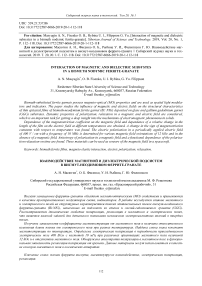Interaction of magnetic and dielectric subsystes in a bismuth nodymic ferrite-granate
Автор: Masyugin A.N., Fisenko O.B., Rybina U.I., Filippson G. Yu.
Журнал: Сибирский аэрокосмический журнал @vestnik-sibsau
Рубрика: Технологические процессы и материалы
Статья в выпуске: 1 т.20, 2019 года.
Бесплатный доступ
Bismuth-substituted ferrite garnets possess magneto-optical (MO) properties and are used as spatial light modula- tors and indicators. The paper studies the influence of magnetic and electric fields on the structural characteristics of thin epitaxial films of bismuth-neodymium ferrite garnet (Bi: NIG) deposited on glass and gallium gadolinium garnet (GGG) substrates. Dynamic properties of polarization, relaxation in a magnetic and electric field are considered, which is an important task for getting a deep insight into the mechanisms of electromagnetic phenomena in solids. Dependence of the magnetostriction coefficient on the magnetic field and dependence of a relative change in the length of the film on the electric field at different temperatures are obtained. A change in the sign of magnetostriction constants with respect to temperature was found. The electric polarization in a periodically applied electric field of 400 V / cm with a frequency of 10 MHz is determined for various magnetic field orientations of 12 kOe and in the absence of a magnetic field. Anisotropy of polarization in a magnetic field and a functional dependence of the polariza- tion relaxation on time are found. These materials can be used as sensors of the magnetic field in a spacecraft.
Bismuth ferrite films, magneto elastic interaction, electric polarization, relaxation
Короткий адрес: https://sciup.org/148321890
IDR: 148321890 | УДК: 539.21:537.86 | DOI: 10.31772/2587-6066-2019-20-1-112-118
Текст научной статьи Interaction of magnetic and dielectric subsystes in a bismuth nodymic ferrite-granate
Introduction. Multiferroics attract interest both from the practical, and from the fundamental point of research of interaction mechanisms between magnetic and electric subsystems [1–5].
Unique combination of magnetic, optical and magneto-optical properties makes bismuth ferrite garnets an attractive material both for theoretical researches and for technological applications. These materials can be used as sensors of the magnetic field in spacecrafts and in writerreader devices resistant to radioactive effects.
Bismuth-substituted ferrite garnets possess magnetooptical (MO) properties and are used as spatial modulators of light, indicators and also other MO of devices in the field of visible light [6–9]. It is established that the increase in replacement of bismuth leads to an increase of MO effects. Thus, for completely substituted Bi3Fe5O12 (BIG) the Faraday spinning effect reaches 25 °/micron for 530 nanometers of the light wavelength. Thereof the garnets substituted with a large amount of bismuth become an attractive material for MO applications. Magnetic anisotropy of films depends on a substrate, the constant of film grating has 0.2 % change when filming on a Gd3Ga5O12 substrate in directions (111) and (100) [10]. Also, in Bi:NIG films Seebeck spin effect was found [11] which can be used in new thermoelectric devices applying the spin current generated by a temperature gradient.
In Bi 3 Fe 5 O 12 applying the method of ferromagnetic resonance with the electric field modulation linear magneto-electric effect with maximum under 450 К was found, mechanism of which has not been determined, however, it has a direct connection with bismuth ions presence [12]. In this regard, the research of interrelation between magnetic and electric properties, having been carried out earlier in a number of connections, [13–16] is relevant for bismuth ferrite garnets as well.
Materials and research methods.
Epitaxial films Nd 1 Bi 2 Fe 5 O 12 (450 nm)/Nd 2 Bi 1 Fe 4 Ga 1 O 12 (90 nm) were examined on the glass substrate and Nd 0.5 Bi 2.5 Fe 5 O 12 (450 nm) – on single-crystalline substrate GGG, grown in crystallographic direction (111). Films were produced applying the method of metalorganic compound decomposition of solution (MOD) [17] at the Technological University of Nagaoka (Japan). The process of film formation consisted of the following stages: applying solution on the metal-organic compounds blended so as to meet Stoichiometry requirements to a film structure on the centrifuge at 3000 rot/min within 60 sec. → drying under 100 °С within 10 minutes → preburning under 450 °С within 10 minutes in the open air → repeating the processes from putting metal-organic solution on the centrifuge before preliminary burning so as to obtain the required film thickness → burning at 650°С for 1 hour in the open air. As a buffer layer on a non-directional glass substrate the film Nd2Bi1Fe4Ga1O12 was formed in advance with 90 nm thickness. Schematic diagram of the process MOD is shown in fig. 1.
Values of constants electro- and magnet- strictions were defined as a relative film deformation under the influence of electric and magnetic fields dL = (R (H;E) – R (H = 0; E = 0)) / R (H = 0; E = 0)), where R (H;E) – strain gage resistance in electric or magnetic field, R (H = 0; E = 0) – strain gage resistance without external fields. The ZFLA-3-11 strain gage was used. Polarization was defined as a pyroelectric charge (Q) divided into the area of contact (A) P = Q/A. Charge was measured applying the Keithley 6517B electrometer.
Results and discussions. Interaction of a magnetic and elastic subsystem can be implemented as a result of the single-ion mechanism, spin-orbit interaction and deformation dependence of exchange on the distance. The latter mechanism is found in the field of magnetic phase transition. Film magnetostriction constants on glass and GGG depending on the external magnetic field directed perpendicular to a film are measured. In fig. 2 and 3 temperature dependences of magnetostriction coefficient in magnetic field of 12 kOe for two films applied on different substrates are presented.
For a film on glass in the range of room temperatures the nonlinear dependence λ is observed (N). Lower than 310 K a magnetostriction constant in magnetic field of H = 12 kOe changes the sign. At a temperature of 200 K the maximum film compression is observed. When cooling from 200 K the constant magnetostriction value decreases and at 80K falls dramatically. A small anisotropy of magnetostriction is observed, so that film lengthening in the magnetic field, perpendicularly applied to a film, exceeds the film lengthening in the direction of the field. Under the film rotation relative magnetic field film lengthening reaches a maximum at coal 24 °. Lower than 280 K a minimum and a maximum of magnetostriction is reached at 30 ° respectively and perpendicular to the film.
The film on GGG substrate at T > 300 K linearly expands in magnetic field and contracts below room temperature. With the temperature decrease magnetostriction changes the sign, passes through a minimum at T = 160 K and similarly to glass practically does not depend on temperature at further cooling (fig. 3). Change of magnetic field orientation hardly influences the magnetostriction constant.
The film electrostriction value Bi: NIGNA on a glass substrate was measured in electric field up to 400 V / cm. The film slightly expands in the external electric field at T = 80 K. Above T = 120 K the film contracts not linearly and reaches the maximum size of compression in fields of 300–400 V/cm at Т > 200 K. At temperatures above room there are two competing mechanisms: the first is connected with the film contraction, the second -with expansion. Magnetostriction in this area of temperatures changes the sign. Film deformation does not depend on the electric field sign. Electrostriction under absolute value increases at temperature rise, passes through a maximum at 200 K and decreases under a further temperature rise up to 360 K.
Polarization of Bi:NIG films is measured in the electric field of 400 V/cm amplitude with a frequency of 10 MHz in the form of a rectangular impulse under various magnetic field orientations. In fig. 4 and 5 dependences of polarization on time are represented at different temperatures for both films.
Over time electric polarization of the film on glass smoothly grows in external electric field. At switching off the field, polarization falls abruptly and changes the sign from positive value to negative below room temperature.
At temperatures over 300 K residual polarization coincides with external electric field by sign (fig. 4).
The time dependence of film polarization on garnet qualitatively differs from films on glass (fig. 5). Under switched off electric field residual polarization remains positive and smoothly increases over time.
Observed effects are explained by charged defects on the film-substrate interface which are compensated by the shift of oxygen ions along certain directions in crystal.
External electric field removes degeneration in the direction of polarization, leads to turning of the local dipolar moments across the field and to the formation of residual polarization. In films on glass there are two interfaces and double electric layer is formed causing the polarization sign change after switching off the field.
In films on glass and on garnets the anisotropy of electric polarization in magnetic field which is caused by magnetoelectric effect is observed.
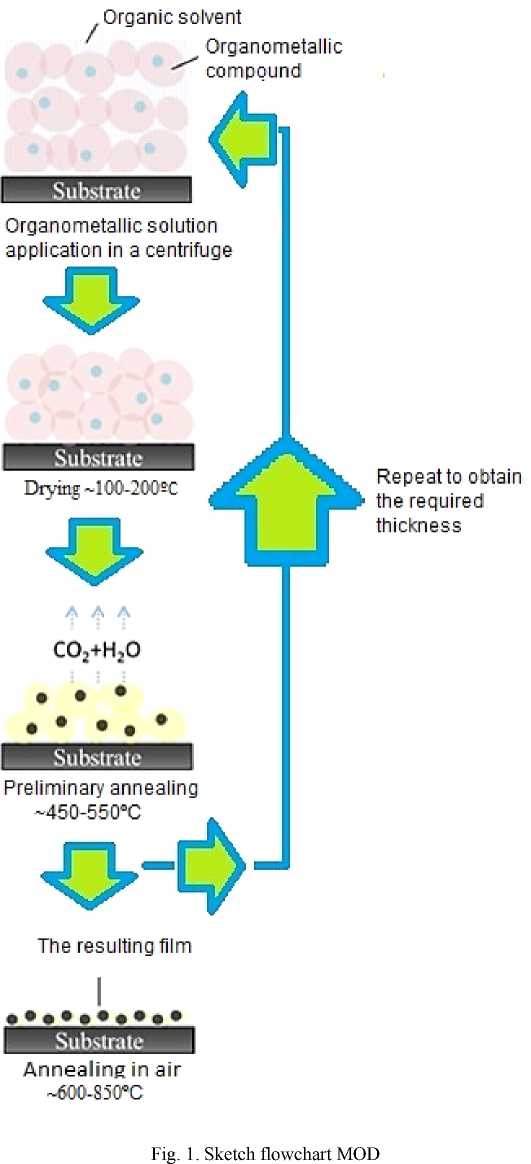
Рис. 1. Эскизная схема технологического процесса MOD
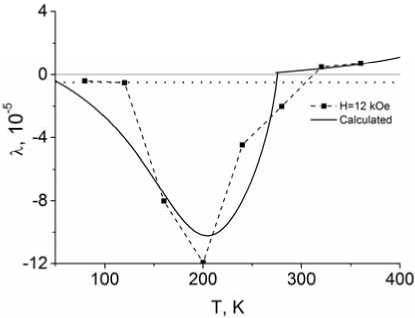
Fig. 2. Dependence of the magnetostriction coefficient on temperature in Bi: NIG on a glass substrate
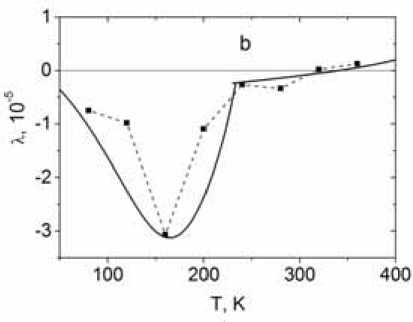
Fig. 3. Dependence of the magnetostriction coefficient on temperature in Bi: NIG on a GGG substrate
Рис. 2. Зависимость коэффициента магнитострикции от температуры в Bi:NIG на подложке из стекла
Рис. 3. Зависимость коэффициента магнитострикции от температуры в Bi:NIG на подложке из GGG
µ C/cm P, µ C/cm
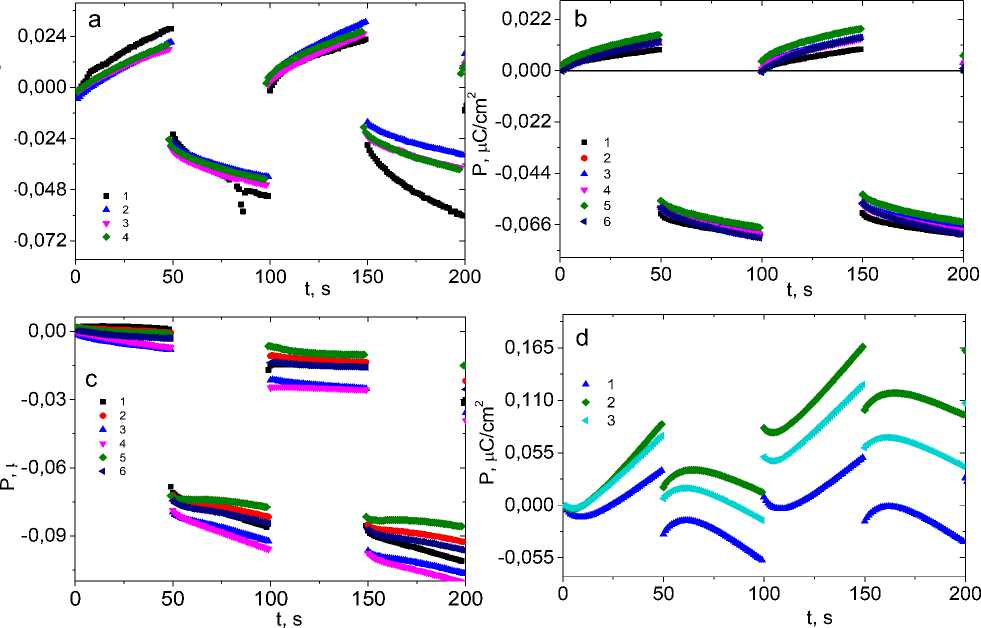
Fig. 4. Polarization of Bi: NIG film on glass over time:
a – at temperatures t = 120º KH = 0 (1), in magnetic fields H = 12 kOe when the magnetic field is oriented relative to the surface normal at angles φ = 90º (2), φ = 180º (3), φ = 360º (4); b – at temperatures t = 200º KH = 0 (1, 6), in magnetic fields H = 12 kOe when the magnetic field is oriented relative to the surface normal at angles φ = 0º (2), φ = 90º (3), φ = 180º ( 4), φ = 360º (5); c – at temperatures t = 280º KH = 0 (1, 6), in magnetic fields H = 12 kOe when the magnetic field is oriented relative to the surface normal at angles φ = 0º (2), φ = 90º (3), φ = 180º ( 4), φ = 360º (5); d – at temperatures t = 360º K H = 0 (3), in magnetic fields H = 12 kOe when the magnetic field is oriented relative to the surface normal at angles φ = 90º (1), φ = 360º (2)
Рис. 4. Поляризация пленки Bi:NIG на стекле от времени:
а – при температурах t = 120º KH = 0 (1), в магнитных полях H = 12 кЭ при ориентации магнитного поля относительно нормали поверхности при углах φ = 90º (2), φ = 180º (3), φ = 360º (4); b – при температурах t = 200º KH = 0 (1, 6), в магнитных полях H = 12 кЭ при ориентации магнитного поля относительно нормали поверхности при углах φ = 0º (2), φ = 90º (3), φ = 180º (4), φ = 360º (5); с – при температурах t = 280º KH = 0 (1, 6), в магнитных полях H = 12 кЭ при ориентации магнитного поля относительно нормали поверхности при углах φ = 0º (2), φ = 90º (3), φ = 180º (4), φ = 360º (5); d – при температурах t = 360º KH = 0 (3), в магнитных полях H = 12 кЭ при ориентации магнитного поля относительно нормали поверхности при углах φ = 90º (1), φ = 360º (2)


Fig. 5. Polarization of Bi: NIG film on GGG over time:
а – at temperatures t = 120º KH = 0 (1, 6), in magnetic fields H = 12 kO when the magnetic field is oriented relative to the surface normal at angles φ = 0º (2), φ = 90º (3), φ = 180º ( 4), φ = 360º (5); b – at temperatures t = 160º KH = 0 (1, 6), in magnetic fields H = 12 kO when the magnetic field is oriented relative to the surface normal at angles φ = 0º (2), φ = 90º (3), φ = 180º ( 4), φ = 360º (5); c – at temperatures t = 280º KH = 0 (1, 6), in magnetic fields H = 12 kOe when the magnetic field is oriented relative to the surface normal at angles φ = 0º (2), φ = 90º (3), φ = 180º ( 4), φ = 360º (5); d – at temperatures t = 320º KH = 0 (1, 6), in magnetic fields H = 12 kOe when the magnetic field is oriented relative to the surface normal at angles φ = 0º (2), φ = 90º (3), φ = 180º ( 4), φ = 360º (5)
Рис. 5. Поляризация пленки Bi:NIG на GGG от времени:
а – при температурах t = 120º KH = 0 (1, 6), в магнитных полях H = 12 кЭ при ориентации магнитного поля относительно нормали поверхности при углах φ = 0º (2), φ = 90º (3), φ = 180º (4), φ = 360º (5); b – при температурах t = 160º KH = 0 (1, 6), в магнитных полях H = 12 кЭ при ориентации магнитного поля относительно нормали поверхности при углах φ = 0º (2), φ = 90º (3), φ = 180º (4), φ = 360º (5); с – при температурах t = 280º KH = 0 (1, 6), в магнитных полях H = 12 кЭ при ориентации магнитного поля относительно нормали поверхности при углах φ = 0º (2), φ = 90º (3), φ = 180º (4), φ = 360º (5);
d – при температурах t = 320º KH = 0 (1, 6), в магнитных полях H = 12 кЭ при ориентации магнитного поля относительно нормали поверхности при углах φ = 0º (2), φ = 90º (3), φ = 180º (4), φ = 360º (5)
Magnetic field orientation angle is defined relative to a film surface normal. Dependence of polarization relaxation on time cannot be described by one functional dependence like an exponent, a logarithm or a power function. Change of electric polarization in magnetic field, under switching on and off electric field of E = 400 V/cm, reaches 40 % and depends on the direction of magnetic field relative to the film
Conclusion. Contraction of films below room temperature has been found in magnetic and electric fields. Magnetostriction sign change under temperature rise in films on glass and on garnet has been revealed. Residual electric polarization after external electric field switching off has been observed. The anisotropy of polarization in external magnetic field has been found which indicates magnetoelectric interaction in bismuth ferrite films.
Acknowledgments. The study was carried out with the financial support of the Russian Foundation for Basic Research, the Government of the Krasnoyarsk Territory, the Krasnoyarsk Regional Science Foundation under the scientific project No. 18-42-240001: “Inversion of the sign of the components of the magnetoelectric tensor on the temperature in bismuth-filled garnet ferrite films replaced by neodymium financial support number 18-32-00079 mol_a.
Список литературы Interaction of magnetic and dielectric subsystes in a bismuth nodymic ferrite-granate
- Диэлектрические и электрические свойства полиморфного пиростаната висмута Bi2Sn2O7 / Л. В. Удод, С. С. Аплеснин, М. Н. Ситников [и др.] // Физика твердого тела. 2014. Т. 56, вып. 7. C. 1267-1271.
- Аплеснин С. С., Ситников М. Н. Магнитотранспортные эффекты в парамагнитном состоянии в GdxMn1-xS // Письма в ЖЭТФ. 2014. Т. 100, вып. 2. C. 104-110.
- Диэлектрические свойства тонких пленок Bi1-xLaxFeO3 / С. С. Аплеснин, А. А. Остапенко, В. В. Кретинин [и др.] // Вестник СибГАУ. 2014. № 3 (55). C. 192-197.
- Bi2(Sn0.95Cr0.05)2O7: Structure, IRspecture, and dielectric properties / S. S. Aplesnin, L.V. Udod, M. N. Sitnikov [et al.] // Ceramics International. 2016. Vol. 42. P. 5177-5183.
- Аплеснин С. С., Ситников М. Н. Магнитоемко- стный эффект в GdxMn1-xS // Физика твердого тела. 2016. Т. 58, вып. 6. C. 1112-1117.

